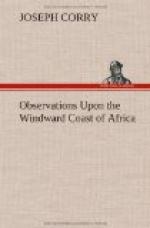There is also an immense animal of this species, which I have heard the natives of this part of the coast describe, often exceeding 30 feet in length, and of an enormous size; it is variegated with spots, and the head is covered with scales; the tongue is fleshy and forked, but its bite is not poisonous; it is to be found in the recesses of caves and thickets, from whence it suddenly darts upon its victim, whether man or beast: it frequently chooses a tree, from which it reconnoitres the passing objects, supporting itself by the tail, which it twists round the trunk or branches: when it seizes animals, especially those of the larger kind, such as lions, tigers, &c. it dexterously, and almost instantaneously twists itself round their bodies in several folds, and by its powerful muscular force, breaks the bones, and bruises it in all its parts; when this is done it covers the animal with a viscous cohesive saliva, by licking its body with its tongue, which facilitates the power of swallowing it entire; this process is tedious, and it gradually sucks in the body, which, if large, renders it incapable of moving for some time, until it digests; and this is the period which the hunters watch to destroy it: it makes a hissing noise like a serpent, and has recourse to a variety of expedients to conceal itself; it is called by the natives Tinnui, and is what I apprehend naturalists term the species of Boa constrictor: it is most commonly found in the sultry climates of Africa, and I believe is also an inhabitant of Asia and America.
Insects are extremely numerous, of a nondescript species, and exceedingly beautiful: the most singular are termites, destructive to houses and fences built of wood; ants, causing ruin to provisions; cockroaches and crickets, destroying leather, linen, and clothes; musquitos, sand-flies, centipedes, scorpions; and wild bees, which are very productive of honey. The vermis and large barnacles abound, which are so destructive to shipping without copper bottoms.
Esculent vegetables are various: Rice, which forms the chief part of the African’s sustenance. The rice-fields or lugars are prepared during the dry season, and the seed is sown in the tornado season, requiring about four or five months growth to bring it to perfection.
Yams, a nutritious substance, known in the West Indies.
Cassada or cassava, a root, of a pleasant taste when roasted or boiled, and makes an excellent cake, superior in whiteness to flour.
Papaw, of a deep green in its growth, but yellqw when ripe, and is an excellent dish when boiled; its leaves are frequently used by the natives for soap; ropes are made of the bark.
Oranges and limes are in great abundance, and of superior quality, throughout the year; but lemons degenerate much in their growth, and in a few years are scarcely to be distinguished from the latter. Guavas, pumpkins, or pumpions, squash water mellons, musk mellons, and cucumbers, grow in the greatest perfection. The pumpkins grow in wild exuberance throughout the year, and make a good pudding or pie.




